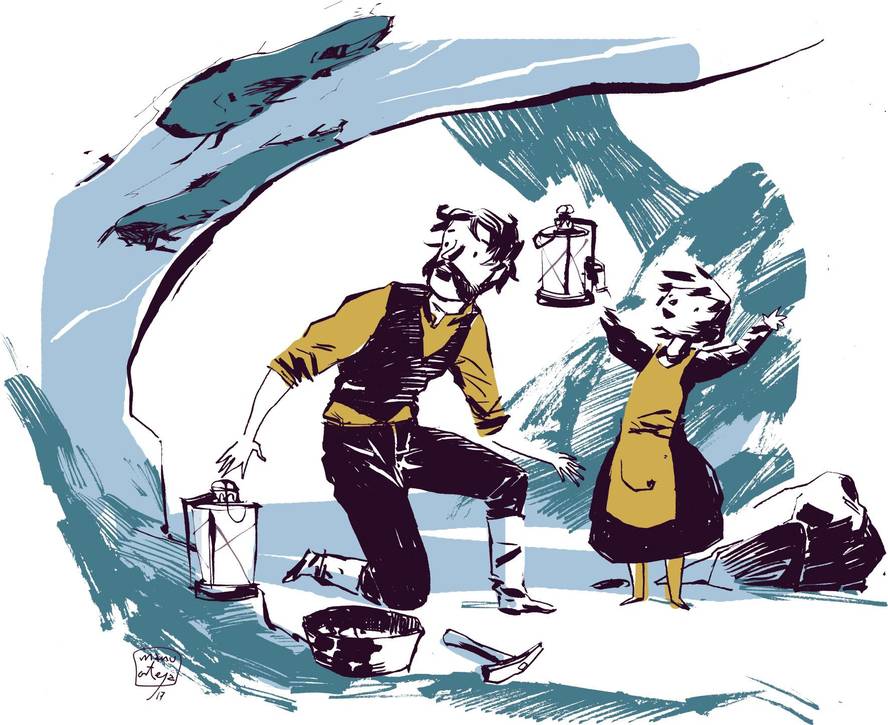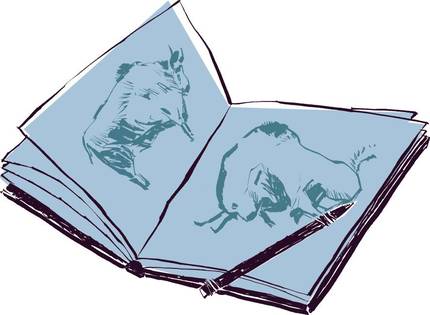Altamira. So old, so beautiful
The parents and daughters entered the cave. Maria was eight years old and was delighted to help her father find prehistoric remains. The previous year, his father was fascinated by those stone and bone objects he saw at the Paris Universal Exhibition in 1878, belonging to prehistoric beings. And he thought that perhaps in his region could be found, for example, in that cave of Santillana del Mar, discovered a couple of years earlier. On Earth he began to look for clues. Meanwhile, Mary enters the cave, the lamp in her hand, until: “Aita, look at oxen!”
Marcelino Sanz de Sautuola approached his daughter. He was illuminating the ceiling with the lamp. My father had his eyes more and more open. The roof was full of images, full of spectacular images of animals made with red and black paintings. He never saw it.
Sanz de Sautuola studied these images well and the rest of those later found in the cave. The excavation also yielded numerous results: shells, animal bones and bone and stone utensils. And in another cave in the area, in the Revilla de Camargo, he found many tools and shells. The following year, in 1880, he published “Brief notes on some prehistoric objects of the province of Santander”.
He concluded that the oxen seen by his daughter were bison, quoting Count Buffon, who according to his works were typical of Europe. It was clear that these images were prehistoric. The animals were to be made by someone who knew them. He argued: “Some discoveries have made it clear that man, when the cave had no other place of residence, knew how to imagine in the branches and teeth of the elephant its image and that of the animals (...), so there is no reason to deny that these paintings are as old as they are”. In addition, he found remains of red ochre among the objects found on the ground. “From all of the above it follows, quite consistently, that the two caves mentioned are, without a doubt, from the time that has been called Paleolithic”.
Others did not see it so clear. This was warned by Juan Vilanova de Piera, professor of Geology and Paleontology, when he learned about the discovery: “You have all the protection of me and my reputation to deal with all the attacks you are likely to receive. I am with you, and I will always be, because I believe it, and I have become convinced of this wonderful thing.” Vilanova, the most prestigious expert in Spain in Prehistory, creationist and passionate anti-Darwinist. According to his ideas, it was not uncommon for man to be born with artistic ability.
But the most prestigious experts in Europe, such as the French Gabriel Mortillet and Émile Cartailhac, were supporters of the ideas of Darwin, evolutionists. According to them, the primitive humans of the Palaeolithic were wild as gorillas, and it was unthinkable that they were able to make such paintings. In fact, Sanz de Sautuola herself made it clear that they were authentic works of art: “It is noted that the author had a practice, since it is seen that they are made by a firm hand that did not hesitate, every trace in a single blow and clean,” he wrote. “It is noteworthy that many of the figures are arranged so that the relief of the ceiling is taken advantage of (...). This shows that the author did not lack artistic sense.”
Upon learning the news, Mortillet wrote Cartaillector warning him that he did not go to that cave: “Don’t trust, friend, it’s a trap that the Jesuits have put on the pre-religious to laugh at us.”
Vilanova and Sanz de Sautuola attended the International Congress of Anthropology and Prehistoric Archaeology held in Lisbon in September 1880. Vilanova presented the discovery. But they were totally rejected. Cartailhace left the room and those who stayed mocked “timadores” and “falsifiers.”
Sanz de Sautuola did not become discouraged and invited Cartailhac to examine the cave. Cartailhace then sent collaborator Édouard Harlé. Although the site was Palaeolithic, the paintings were modern.
Similar conclusions were obtained in Spain. A report by members of the prestigious ILE Free Education Organization in Madrid showed that the prehistory of these paintings was incompatible with the ideas of evolution, and suggested that the Cantabrian wars could be carried out by the Romans who took refuge in the cave.
In the Spanish Society of Natural History two sessions were held to discuss the subject and, although Vilanova explained its reasons, they concluded that the paintings were false. “It is the work of a disciple of modern art who does not know of prehistory”, judged Eugenio Lemus. And Ignacio Bolívar said: “The perfection and proportions of the images show that the author had knowledge of perspective and dominated great lines, two things that cannot be attributed to a wild man.”
In addition, the rumor of the mute French painter Paul Ratier spread. In fact, Ratier, at the request of Sanz de Sautuola, dedicated himself to making copies of the cave paintings.
Sanz de Sautuola died in 1888. Also Vilanova, five years later.
In 1902 his daughter Maria received an unexpected visit: Cartailhac. He came to ask forgiveness. He had just published “Coats with paintings, cave of Altamira. Article “mea culpa” of a skeptic. In fact, from 1895 paintings began to be found in several French caves.
Together with Henri Breuile, Cartailhace studied Altamira's paintings in depth. Write to your friend Gustave Chauvet: “Dear friend, my father Breuil and I want you to be here in the cave of Altamira. It is the most beautiful of all caves with paintings, the most curious, the most interesting, (...) those bison, horses, deer and prehistoric wild boars, all so surprising (...) We live in a new world”.
Bibliography:
ANSEDE, M. (2012): “The Spaniard who opposed Darwin armed with the Bible.” Matter.
ARRIETA, J. (2013): “The skeptic who was wrong in Altamira.” El Diario Montañés.
CERPA, S.A. (2013): “Altamira, a calvary for Marcelino Sanz de Sautuola”. History and Archaeology.
García del Valle, R. “Marcelino Sanz de Sautuola in Altamira. History of a scientific ordeal.” TheCult.es.
PELAYO, F. (2016): “Why was the discovery of Altamira’s rock art so controversial?” El País.
SANZ DE SAUTUOLA, M.; LASHERAS, S.A. and DE LAS HERAS, C. (2004): “Brief notes on some prehistoric objects in the province of Santander”. Turner.







